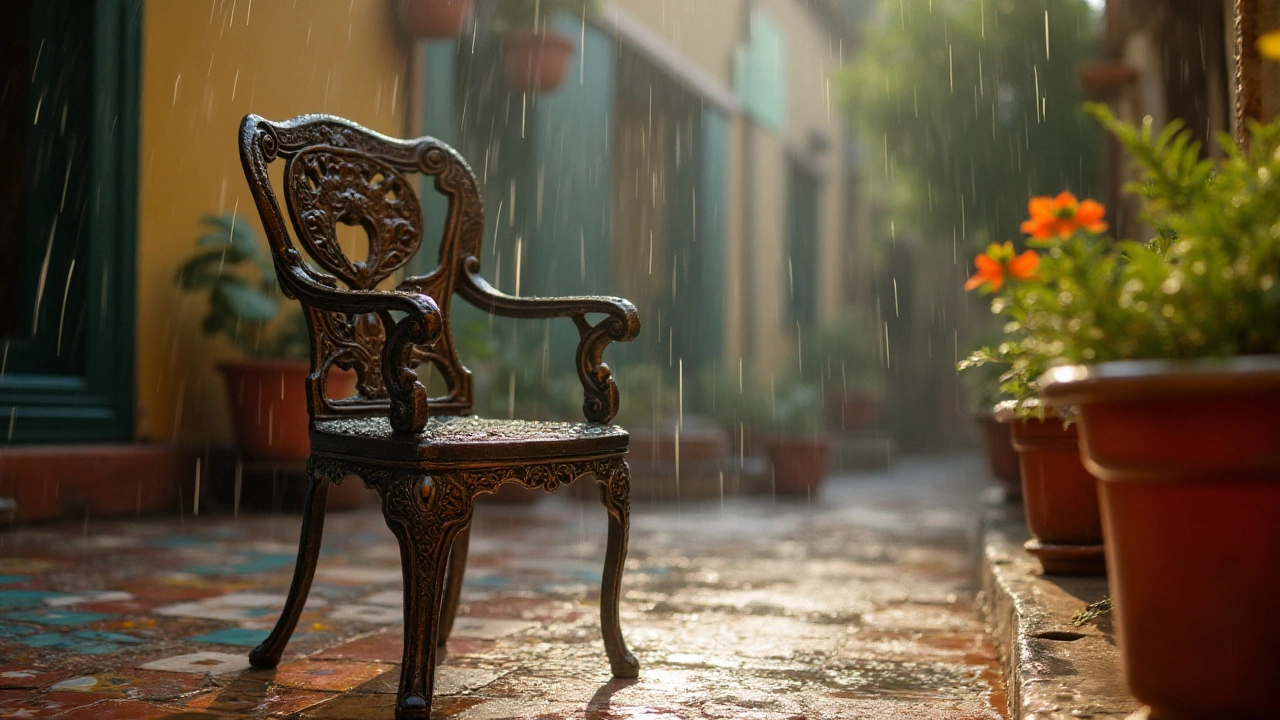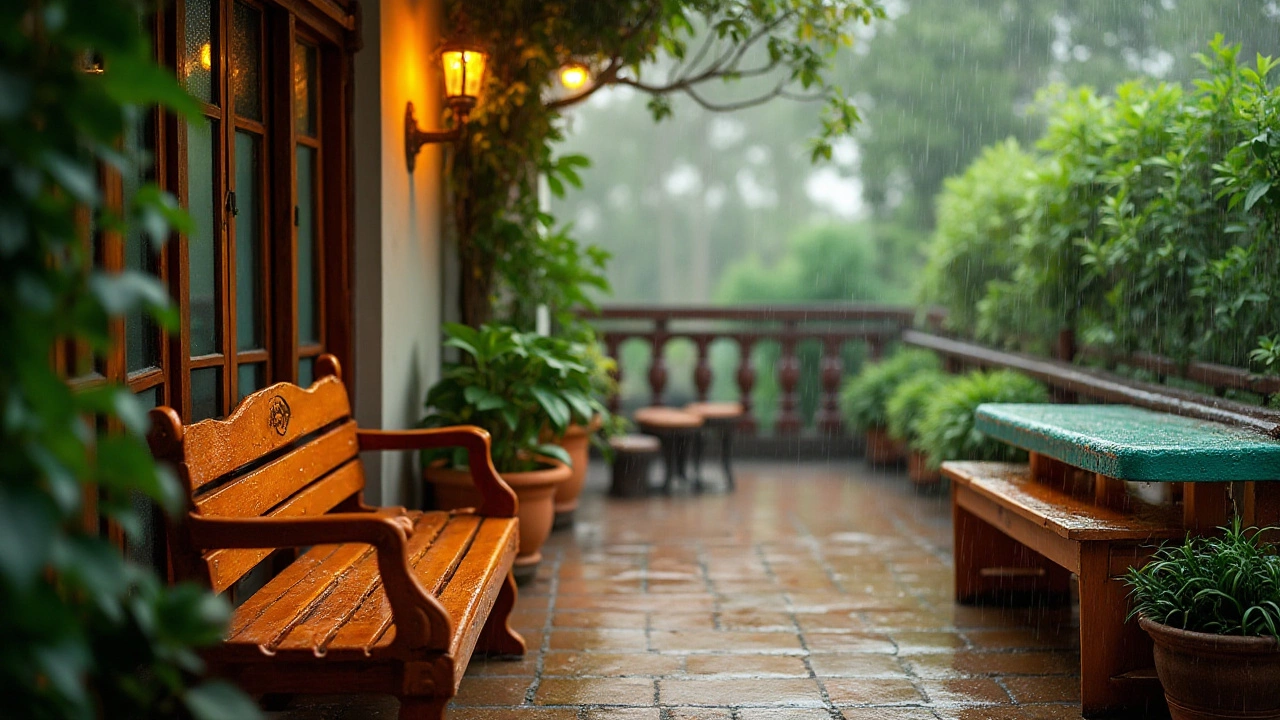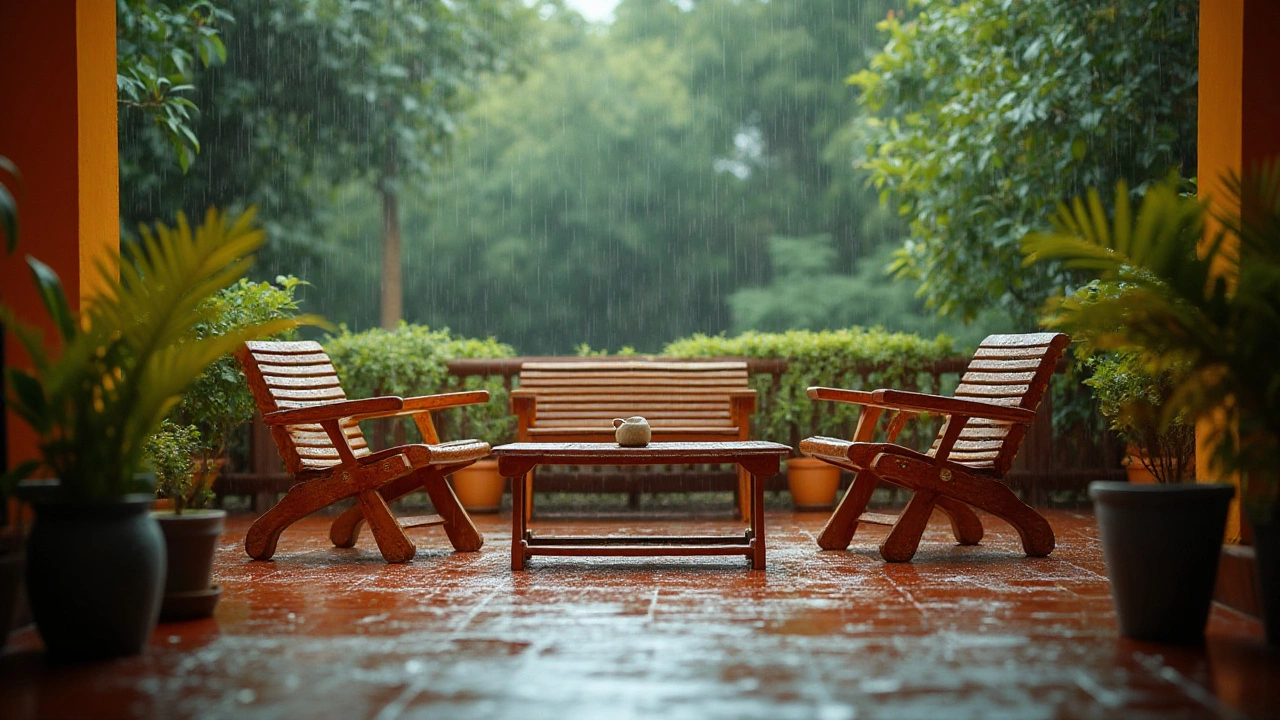Outdoor furniture often claims to be weather-resistant, promising durability through spring showers and summer storms. But can you truly trust these claims, or are they just marketing buzzwords? This curiosity is what drives our exploration today. As rain clouds gather, many find themselves worrying about the safety of their beloved garden setups. Is it worth the risk to leave them out?
To make the best decision, you must understand how different materials respond when left in the rain. Knowing the secrets of wood, metal, and plastic endurance can guide you in your choices. Whether you have a wooden bench or a metal dining set, treating them right ensures they remain picturesque, rain or shine. Here, we uncover the strategies to keep your outdoor oasis flourishing, despite the weather's whims.
- Understanding Material Durability
- Effects of Rain on Different Surfaces
- Protecting Your Furniture from Weather
- Seasonal Maintenance Tips
- Common Myths and Truths
Understanding Material Durability
When venturing into the world of outdoor furniture, one cannot overlook the significance of material durability, especially when it's about braving the rainy days. Not all materials are created equal; each comes with its strengths and weaknesses, especially when it faces the elements. Take wood, for instance. While it's a staple for its classic appeal and natural beauty, not every type of wood is suitable for weatherproof furniture. Hardwoods like teak, eucalyptus, and cedar are renowned for outdoor use due to their dense fibers and natural oils, which make them resistant to decay and insect infestation. However, this doesn't mean they are invincible. Even the sturdiest wooden pieces can suffer if left untreated, warping or splitting over time under constant moisture assault.
Moving next to metal, an often go-to for sturdy and intricate designs, offering an elegance that plastic seldom matches. Metals like aluminum and wrought iron feature prominently in garden setups. Aluminum is celebrated for being rust-proof and lightweight, making it easier to maneuver. But its downfall lies in its potential to be blown about during storms if not weighted correctly. On the contrary, wrought iron is heavy and exudes timeless charm, yet it demands diligent attention to rust potential, necessitating periodic maintenance. Imagine the elegance of a wrought iron table set fading away, consumed by rust and neglect. A comprehensive understanding of these attributes can greatly influence a purchase decision and maintenance routine.
Plastic and resin are often underrated but offer vast possibilities when correctly crafted. Typically, less expensive and available in a variety of designs, they are naturally resistant to moisture, a considerable advantage. However, they may lose color and become brittle under prolonged sun exposure. The trick with plastics lies not with the rain, but with the sun that can take its toll over years of relentless exposure. Yet, with newer technologies, UV-resistant sprays and finishes offer some level of protection, prolonging aesthetics and functionality. When considering
"The true secret of luxury is not the price tag but enduring beauty that defies the ravages of time," says renowned interior designer Charles Bernard.it's evident that understanding your materials is crucial for lasting enjoyment.
For those with an analytical mind interested in data, here's an intriguing set of comparisons for durability among common materials:
| Material | Durability Rating (1-10) | Rain Resistance |
|---|---|---|
| Teak Wood | 9 | High |
| Aluminum | 8 | High |
| Plastic/Resin | 6 | Medium |
| Wrought Iron | 7 | Mid |
The benefits of checking materials extend beyond merely buying preferences. This awareness allows for better care, knowing precisely when and how to treat each piece, ensuring longevity and sustained beauty. Opting for durable garden furniture is an investment in time, aesthetics, and peace of mind, allowing each piece to withstand whatever Mother Nature chooses to throw its way. When knowledge melds with care, outdoor spaces blossom with life and grace.
Effects of Rain on Different Surfaces
Rain can have varied impacts on outdoor furniture, depending heavily on the material used. The first material to consider is wood, commonly found in many garden sets. While treated wood is often remarked as being weatherproof, it's still a story of maintenance and care. Excessive water exposure can lead to swelling, warping, or even rotting over time, especially if the wood isn't sealed correctly. Even the resilient teak must contend with the elements, as relentless rain may still leach its natural oils, leading to a silver patina—a beautiful effect to some, yet deteriorating for others. Interestingly, studies from the Journal of Agricultural and Food Chemistry have noted that certain wood treatment techniques can extend longevity by up to 30%, keeping rain damage at bay longer.
On a different note, metal often seems impervious, but it is not without its challenges. Metals like iron and steel can rust if exposed to rain for long durations, leading to not just aesthetic issues but structural weakening as well. Aluminum and stainless steel, on the other hand, contain built-in resilience against rust, making them a safer bet for wet climates. With regular maintenance like wiping down surfaces and storing them during storms, metal furniture can have a long life. As expert gardener Mark Lewis once mentioned in his book, "Proper treatment and choice of paint technology can protect metal for years, making it almost as good as any natural material," highlighting the pivotal role of protective coatings. This reassurance can't be overstated as many worry about the dreaded rust discoloration marring their outdoor look.
Plastic, often lauded for its versatile uses, does well in rain but is not without its set of peculiarities. While synthetic materials do not degrade in the same way as wood or metal, problems like fading from UV exposure can creep up, which is an often overlooked issue. Rain itself doesn't damage plastic, but consistent water can lead to dirt buildup, mold, and griming over time if neglected. The challenge becomes maintaining its sheen and vibrancy, which may require simple regular cleanings with soapy water and occasional polish. A practical guide to this was highlighted in a 2022 article from Garden Living Magazine, which suggests setting up an undercover storage area as a precaution, helping extend the life of all material types vastly.
But let’s not forget the intricate matter of upholstery. Cushions and fabrics used in outdoor settings encounter their own trials with rain exposure. Take, for example, the much-needed consideration of water-resistant covers. While marketed as resilient, prolonged moisture can still seep in, leading to fungi and mildew. The security lies in the density of the fabric weave and its protective coatings, compelling occasional reinforcements like regular washing and employing breathable storage solutions. With attention to these nuances, homeowners can enjoy their garden furniture looking chic and fresh—no matter how grey the skies get. Indeed, investing in removable and easy-to-clean covers can add years to your outdoor seating setup.

Protecting Your Furniture from Weather
Weather-related damage is the bane of outdoor furniture lovers, but hiding indoors isn't your only option. A preventive approach goes a long way. Begin by understanding your furniture's material needs. Each material—be it wood, metal, or plastic—demands different care techniques to withstand rain. For instance, wooden furniture often comes pre-treated but may need annual sealant applications, especially if it sits exposed year-round. This process creates a barrier that minimizes moisture absorption, preserving the wood's natural allure. Metals, though often powder-coated or painted, can rust. Spotting rust early and using sealants or paint offers extended shelf life. Plastic pieces are generally tough against rain, yet they could degrade over time when hit by UV rays. Using covers for UV protection is advisable.
Embracing protective covers can be a game-changer. These are particularly beneficial when heavy rains and storms are frequent. Ensure covers are breathable to prevent mold growth or condensation. A tight fit shields the furniture effectively and stops moisture infiltration. Checking covers for durability is crucial, as low-quality ones might perish under harsh weather. Investing in reliable covers warrants that your garden furniture stays fresh. Interestingly, a study by Market Research Company found quality covers could extend furniture life by a solid 30%—a figure not to be ignored. For customized solutions, local stores often offer both readymade covers suitable for typical setups or can fashion unique dimensions that elegantly drape over your specific furniture profiles.
As The New York Times suggests, "Weather protection is not merely a precaution; it's part of the maintenance ritual." They emphasize blending aesthetics with practicality by choosing covers that complement outdoor themes.
Positioning furniture thoughtfully in your outdoor space also lends a hand in its longevity. Observe your site’s drainage patterns, avoiding placement where water pools. Elevated surfaces or gravel bases facilitate water runoff, sparing your furniture from constant exposure. If your premise enjoys a pergola or awning, use it to shelter the furniture. These structures offer ample protection, reducing the need for constant vigilance. In storm-prone regions, additional measures like securing furniture to avoid being swept away by winds become essential. This also prevents accidental knocking over, which can cause structural damage.
If you desire comprehensive protection, consider creating an indoor storage spot during extreme conditions. Transitional yards often use sheds or garages as interim storage spaces. When space is a constraint, consider foldable or stackable furniture, designed to offer storage ease without compromising comfort or style. Don't shy away from rotating and reorganizing pieces. Regularly shifting your furniture keeps overshadowed spots refreshed and elongates their appeal.
Seasonal Maintenance Tips
Keeping your outdoor furniture in top shape requires a bit of attention throughout the year, and seasonal maintenance plays a crucial role. As seasons change, so do the elements your garden furniture faces. A little foresight can extend its life while maintaining its aesthetic appeal. In spring, once freezing temperatures have subsided, it’s a great time to begin assessing your furniture's condition. Start by washing away the winter grime, which often clings to surfaces unnoticed. A mixture of mild detergent and water can work wonders. Just be sure to rinse thoroughly, avoiding soap residue that can attract dirt.
The arrival of summer brings its own challenges. The sun can be cruel as it beats down on your cherished pieces, particularly if they feature bright colors. Protection is key here. Embrace the use of protective covers, and on scorching days, consider storing certain items in shaded spots. Consistent exposure to UV rays can lead to fading, so it's worth investing in specialist furniture sunscreen or sealant for wooden items. If your furniture includes cushions, opting for removable, washable covers will keep them fresh with minimal effort. Rotating cushions regularly helps avoid uneven fading, maintaining the vibrant look of your seating area throughout sun-soaked months.
Autumn signals a season of preparation as rain showers become frequent, and it’s essential to re-seal wooden furniture against the increased moisture. This is when your earlier cleansing comes into play, as a clean surface is best for sealant applications. Metals can be cared for with a light polish, preventing rust. Doing so before moisture sets in is a preventive measure that can save you from heavier corrosion issues. As leaves fall, regularly brush them off surfaces to prevent staining from moisture-trapped decomposing leaves.
Winter often means putting some outdoor pieces into storage, especially more fragile materials. Before stacking them away, ensure they are completely dry to prevent mold and mildew. Moisture trapped during storage is a surefire way to diminish quality. For furniture that cannot be moved indoors, using high-quality, weather-resistant covers is imperative. Consider slight elevation using blocks to avoid ground moisture seepage, particularly for wooden items. A well-kept garden space can remain a beacon of serenity, even as snow blankets the rest of the world outside.
Indeed, proper seasonal care enhances the durability of garden furniture, ensuring it remains both functional and beautiful. As industry expert Sally Johnson once said,
"A stitch in time saves nine, and a simple cleaning routine or cover can save costly replacements. It's about working smart for your outdoor space."A regular glance at upcoming weather can also guide you in last-minute adjustments. With this foreknowledge, your garden can weather the most trying conditions, continuing to offer solace and beauty year-round.

Common Myths and Truths
When it comes to leaving outdoor furniture in the rain, many myths swirl around, sometimes as wild as the storms we strive to weather. One prevalent myth claims that any wood furniture left outside will inevitably rot. While it is true that untreated wood can be susceptible to water damage, not all wood is created equal. For instance, teak, one of the most popular choices for outdoor use, boasts natural oils that grant it resistance to both water and termites. However, even teak benefits from seasonal maintenance to uphold its integrity. Skeptics often overlook the value of simple habits, like covering or relocating wood furniture during inclement weather, that can drastically extend its lifespan and appearance.
Another common misconception floating in garden circles is that any furniture labeled as 'weatherproof' is invincible to rain damage. In reality, 'weatherproof' often simply means it offers some resistance to common outdoor challenges, but not immunity. This term doesn’t render furniture indestructible; instead, it's a clue urging owners to take additional protective measures. This is where materials like metals come into play. Although metals such as aluminum resist rust, even they might not appreciate the zing of acidic rain or saltwater exposure. Consider investing in protective coatings or furniture covers to support your set’s integrity. In fact, a respected environmental journal once stated, "Rusting is not an inevitability for metal furniture if proper care and cover are employed wisely."
Then there's the myth about plastic furniture; some believe it gets brittle when exposed to too much sun and rain. In truth, not all plastics wilt under weather’s whims. High-density polyethylene (HDPE), praised for its durability and recyclability, is an excellent choice for garden care. Still, nothing lasts forever without care, and even plastics can become provocatively faded or weakened without a loving polish and the occasional wash. When it comes to weatherproof furniture, many truths come down to conscientious choices and sustainability. Adopting practices to shield your pieces from extreme conditions, be it through thoughtful relocation or the application of protective agents, often spells the difference between a garden marvel and a forgotten relic.
Lastly, savvy homeowners often weigh the need to invest in covers for garden furniture. Some argue these are unnecessary, considering the furniture is meant to brave the outdoors. However, a smart cover acts as a partnership rather than a crutch, tackling dirt, leaves, and sun fading before they become adversaries to design and function. A little extra attention goes a long way and reflects a different kind of nurturing akin to a well-run household or lovingly tended garden. Remember, every piece of furniture comes with its narrative of material, make, and personal investment. So, while myths around rain and furniture often misconstrue an intricate story, the truths are accessible for those ready to delve into well-paced care and informed decision-making.

